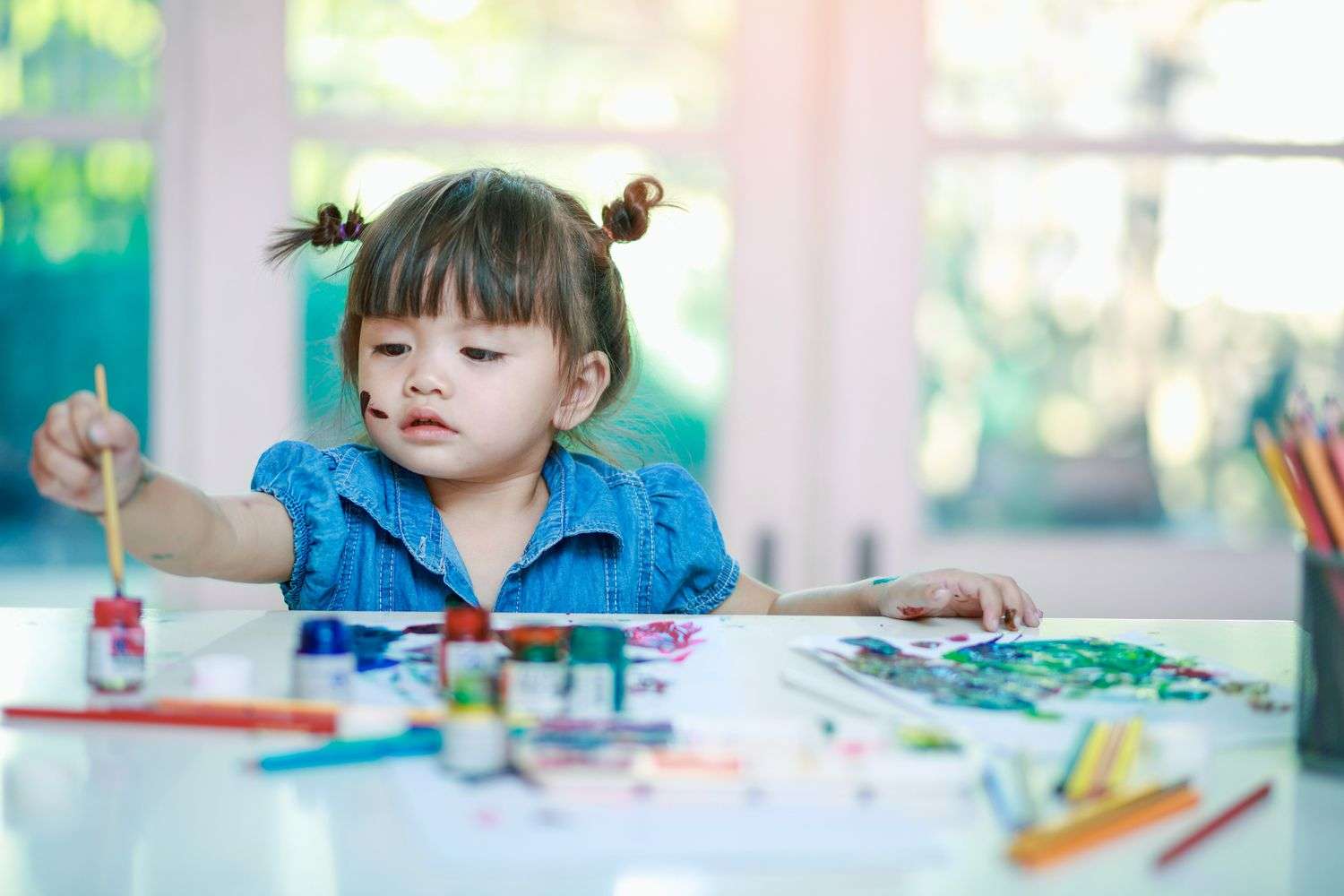According to the American Art Therapy Association, “Art therapy is a mental health profession that uses the creative process of art-making to improve and enhance the physical, mental, and emotional well-being of individuals of all ages. It is based on the belief that the creative process involved in artistic self-expression helps people to resolve conflicts and problems, develop interpersonal skills, manage behavior, reduce stress, increase self-esteem, and self-awareness, and achieve insight.”
There is no single way to provide art therapy; as a result, it can look very different when practiced by and with different individuals. It can be free-flowing or structured, open-ended or goal-oriented. For children and adults with autism, it can be a wonderful way to open doors to self-expression and engagement.
![]()
Busakorn Pongparnit / Getty Images
Why Use Art Therapy to Treat Autism?
One of the hallmarks of autism spectrum disorders is a difficulty with verbal and social communication. In some cases, people with autism are literally nonverbal and unable to use speech to communicate at all. In other cases, people with autism have a hard time processing language and turning it into smooth, easy conversation. People with autism may also have a tough time reading faces and body language. As a result, they may have difficulty with telling a joke from a statement or sarcasm from sincerity.
Meanwhile, many people with autism have an extraordinary ability to think visually ”in pictures.” Many can turn that ability to good use in processing memories, recording images and visual information, and expressing ideas through drawing or other artistic media. Art is a form of expression that requires little or no verbal interaction that can open doors to communication.
All too often, it’s assumed that a nonverbal person or a person with limited verbal capabilities is incompetent in other areas. As a result, people on the autism spectrum may not be exposed to opportunities to use artistic media, or the opportunities may be too challenging in other ways (in large class settings, for example). Art therapy offers an opportunity for therapists to work one-on-one with individuals on the autism spectrum to build a wide range of skills in a manner which may be more comfortable (and thus more effective) than spoken language.
How Art Therapy Is Different From Art Classes
Art therapy is a tool for helping clients to access their emotions. By contrast, art classes are intended to provide students with instruction on how to achieve specific artistic effects or goals. While art classes may be appropriate for individuals with autism, they are not a substitute for art therapy.
What Art Therapists Do for People With Autism
The research is somewhat sketchy regarding the impact of art therapy on people with autism. The literature consists mainly of case studies and papers describing the observed impact of art therapy programs. Some of the papers written and presented on the subject, however, suggest that art therapy can do a great deal. In some cases, it has opened up a whole world of opportunity to an individual with autism who has significant artistic talent. In other cases, it has created a unique opportunity for personal bonding. Other possible outcomes include:
- improved ability to imagine and think symbolically
- improved ability to recognize and respond to facial expressions
- improved ability to manage sensory issues (problems with stickiness, etc.)
- improved fine motor skills
How to Find and Select an Art Therapist
Qualified art therapists hold a masters degree and are certified by the Art Therapy Credentials Board. Not all qualified art therapists, however, have specific experience working with people on the autism spectrum. Many specialize in working, for example, with trauma victims, individuals with mental illness, etc. To find an art therapist, start with the Art Therapy Credentials Board’s online therapist locator.
When you’ve located a local therapist, call to find out what experience that individual has had with autism spectrum disorders. While extensive experience may not be critical, it is very important that the therapist you choose understands the specific issues, challenges, and strengths associated with autism. It’s important to note that art therapy is not just for young children, or even for children in general. Its usefulness has been established for people of all ages, including adults.

Art Therapy Activities for Autism
For decades, creative art therapies have been used in psychotherapy to enhance the mental, emotional, and physical wellbeing of individuals across all age groups, particularly children. Through the art of creativity, therapists can help enhance a child’s imagination, improve skills, and develop their ability to communicate. This approach is particularly beneficial among children with autism.
The CDC reported that approximately 1 in 54 children in the United States is diagnosed with autism. However, early intervention can significantly improve outcomes. Art has been shown to be a highly beneficial intervention tool for children with autism, allowing these individuals to freely express their thoughts and feelings.
If you are parenting a child with autism, here’s how art therapy can assist your child, helping them build life skills while promoting healthy self-expression.
How Does Art Therapy Help Autism?
Whether your child is interested in music, drama, visual arts, or dance, autism art therapy is an incredible way for children to communicate and express themselves non-verbally. Just some of the ways in which art therapy is useful to children on the autism spectrum include:
-
Enhanced communication through creative expression
-
Improved imagination and greater abstract thinking
-
The ability to build stronger relationships while encouraging children with autism to see other people’s perspectives
-
Greater sensory integration while improving coping skills
-
Enhanced development while building visual/spatial skills
-
Greater emotional and sensory regulation, which has a positive impact on behavior
Art is so beneficial in that it is highly subjective. It is important to remember that each child with autism is a unique individual, with unique abilities, strengths, and needs. Since the most effective interventions are those that are personalized to meet the individualized characteristics of each child, children with autism can thrive in a creative, non-restrictive environment — one that allows them to think in pictures in a free-flowing manner.
Although each child’s experience will differ, one of the most common goals associated with art therapy is to increase tolerance for unpleasant stimuli while aiming to channel self-stimulating behavior into creative play. Since art is enjoyable for children, creative projects encourage kids with autism to tolerate various stimuli that they would normally avoid (i.e. the texture of construction paper or the smell of paint).
The goal is to help the child become desensitized to similar sensations so that they become more bearable in everyday life. This will allow them to benefit at home and school, as they learn to interact with peers and family members in a more positive manner, better regulate their emotions, and develop greater self-confidence.
How art therapy is helping children with autism express themselves?
Art therapy can build a pathway for children with autism to express their feelings and impressions of the world. They use their creative side to decide the color choices, to use different materials into their own visual form.
How to Get Started With Art Therapy Activities for Children With Autism
Art therapy can begin for a child with autism as early as age two or three. In a world that may be otherwise confusing and often overwhelming, art can provide a problem-solving solution that better suits the child’s thinking style. Whether your goal is to help your child explore and understand their feelings or decrease certain behavioral issues, here are some ideas to get started.
While it’s important to work closely with your child’s art therapist, as these professionals hold expertise in fine arts and counseling, you can actively work with your child at home, helping them expand on what they’ve learned in therapy. Of course, you’ll need to find what works best for your child. However, the following strategies can help kickstart their creative journey.
- Ice cube drawings
— Although many children begin using paints through the art of finger painting, for many children with autism, this can be an uncomfortable experience. This is why many art therapists introduce paint brushes with long handles or other objects that allow children to express themselves without having to physically touch the paint. For ice drawings, mix non-toxic acrylic paints with a small amount of water. Combine in small cups and pour this mixture into an ice cube tray. Place a popsicle stick in each section and cover with foil so that they remain upright. Place the tray in the freezer and then allow your child to paint a masterpiece.
- Sand art
— Some children find sand art very therapeutic, especially those who showcase restricted, repetitive patterns of behavior. As children peel sections and introduce colors of their choosing, they can create a masterpiece at their own pace. This can also be a great activity to do together, encouraging greater social interaction. For example, you may be responsible for peeling away sections while your child chooses a color, before applying the sand, providing them an immediate reward for their effort.
-
One key study
found that a 10-week sandplay program increased verbal expression, as well as social interactions and increased spontaneous play among kids with autism
-
- Playdough sculptures
— Playdough is a great sensory material, making it ideal for structured, sensory, and pretend play.
Here is a quick and easy recipe
that you can make at home. If your child is receptive, make scented play dough to create easily identifiable smells, using ingredients such as lemon juice or cinnamon.
Best Practices
A 2017 study, published in The Arts in Psychotherapy, discussed guidelines and best practices for delivering art therapy to children who have autism spectrum disorder. Some of the best practices found were:
-
Use the same routine when beginning each session — some degree of structure is important
-
Explain instructions in a consistent manner
-
Spark curiosity in order to teach new skills
-
Be aware of transitions between activities
In contrast, it was found that certain aspects of practice were not useful. Factors that may have adverse effects include:
-
Being overly directive
-
Being too lax with direction
-
Using art materials that are over-stimulating — or providing too many options
-
Forcing or being too restrictive with communication styles
As you encourage your child to continue to embark on their art therapy journey, remember, autism is not a disability — it is simply a different ability. Actively work with your child to help them thrive.
Carmen B. Pingree is dedicated to providing comprehensive treatment, education, and services like in-home therapy for children with autism. We are here to be a resource and service for all parents. If you are looking for more beneficial resources, please refer to the following:


